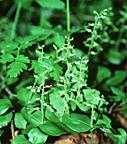Listera convallarioides (Sw.) Nutt.
Broad-leaved twayblade
The specific epithet convallarioides is from the Latin meaning "Convallaria-like,"
apparently because Swartz felt that the leaves of Listera convallarioides
resembled those of the genus Convallaria (the Lily-of-the-Valley.

DESCRIPTION: Plant
glabrous below inflorescence, 12-25 cm tall, arising from an cluster of
slender, fibrous roots. Leaves two, opposite, located near the middle
of the stem, ovate-elliptical to nearly orbicular, 3-6 cm long and 2.5-5
cm wide. Midrib +/- prominent, forming a slight keel below. Inflorescence
a lax terminal raceme of translucent green flowers, 7-20 flowered; each
flower subtended by a minute lanceolate bract. Scape of inflorescence finely
pubescent. Dorsal sepal elliptical to lanceolate, reflexed, 4-5 mm
long and 1-2 mm wide, green; lateral sepals lanceolate to linear-lanceolate,
distinctly falcate and reflexed, 4.5-5.5 mm long and about 1-1.5 mm wide,
green. Petals linear and only slightly falcate, 4-5 mm long and about
1 mm wide, colored as the sepals; typically reflexed back along the ovary.
Labellum cuneate; 7-11 mm long and 3-5 mm wide, the apex rounded
and slightly lobed, typically with a minute tooth between the lobes, the
base of the lip attenuated into a thin stalk (or claw) with a pair of small
projections at the point of constriction; colored as sepals and petals,
central portion typically thickened and darker green.
SIMILAR SPECIES: Listera convallarioides is most likely to be
confused with other species of Listera, but can be easily distinguished
by its cuneate, undivided labellum. The two other species of Listera
found in Wisconsin, L. auriculata and
L. cordata,
both have labella that are deeply divided, whereas the labellum of L.
convallarioides is barely notched at its apex.
HABITAT: Listera convallarioides is usually found in moist northern
mixed deciduous/coniferous forests, where it frequently is found growing
in moist to mucky humus in shallow depressions. In such situations it may
form extensive colonies.
FLOWERING DATES: Early July-early August.
POLLINATION: Unknown in the published literature. However, given that
Listera cordata is pollinated by fungus gnats, and my observation
of a similar insect pollinating L. auriculata, it seems likely that
L. convallarioides is also pollinated by fungus gnats.
DISCUSSION: This species hybridizes with Listera auriculata
to form the hybrid L. X veltmanii Case (Case
1964), which has been collected in Bayfield County. The hybrid is generally
intermediate between the two parents, particularly in the shape of the labellum.
Catling (1976) has written detailed
description of this hybrid and its distribution.
WI DISTRIBUTION:  U.S. DISTRIBUTION:
U.S. DISTRIBUTION:
Go directly to Wisconsin herbarium
records.
Return to the main LIST of
the Orchids of Wisconsin.
Return to the main KEY to the Orchids of
Wisconsin.

 U.S. DISTRIBUTION:
U.S. DISTRIBUTION: